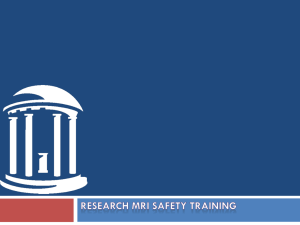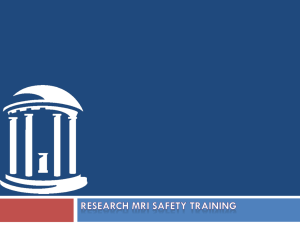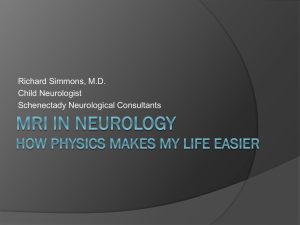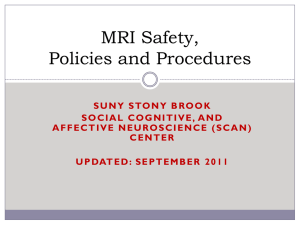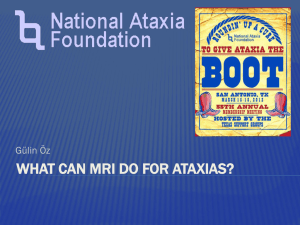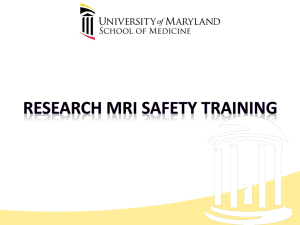MRI Safety Training PowerPoint Presentation
advertisement
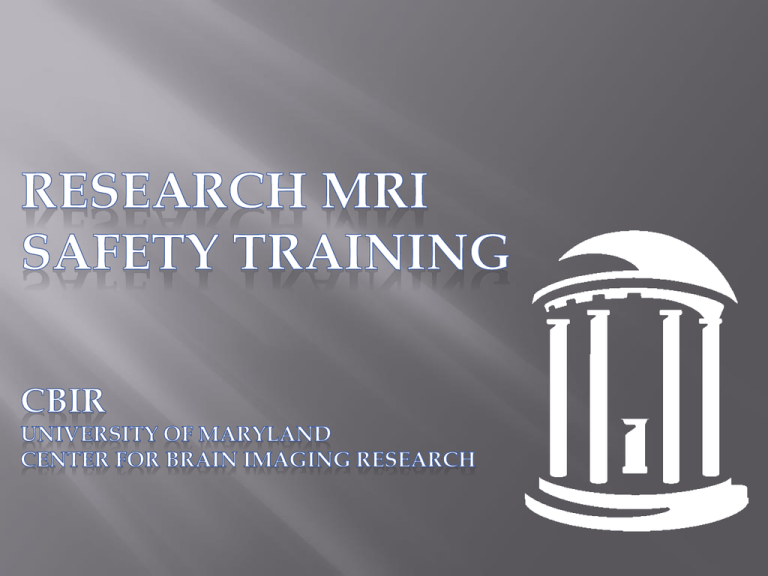
MRI safety training is required for all faculty, staff and students who will work around and inside the MRI magnet rooms or will need access to the area. 1. 2. 3. 4. 5. 6. Safety training schedule Potential dangers of MRI Safety Signage Importance of proper safety Regulating those around you Emergency situations Safety training should be completed annually and will consist of: 1. 2. 3. 4. Filling out a personal MRI Screening Form Reviewing safety PowerPoint Watching the MRI safety video Passing the MRI safety quiz • • • • To ensure patient safety, completion of the MRI screening form is required prior to every MRI scan. The MRI Screening Form is used to help identify any potential dangers for you and your patients / subjects. The form consists of a series of questions intended to identify any metallic objects within your body that could be affected by the magnetic field. 2 screening forms are required: - During the consent process (RA) - Before the MRI (MRI Operator) MRI Screening Sheet Ideally, the form should be filled out by: a. The Patient If the patient cannot fill it out: b. Family Members If there are no family members: c. Referring MD ALL EMPLOYEES MUST BE SCREENED TO WORK IN A MAGNETIC FIELD ENVIRONMENT JUST LIKE THE PATIENTS. NO EXCEPTIONS. NO ONE should enter the scan room without first being cleared by an MRI operator. Some implants/devices are contraindications for an MRI scan If a subject answers “yes” to any question on the MRI screening form, that issue must be addressed and resolved prior to entering the scan room NO cardiac pacemakers, defibrillators, aneurysm clips or electronic or magnetically activated devices Any injury from a foreign metallic body may be a contraindication for an MRI scan If someone has worked as a machinist, grinder, or welder and cannot absolutely confirm they always wore eye protection, they must first have orbital x-rays to confirm that there are no loose metallic bodies in the eye Any person who was injured by a metallic foreign body such as a bullet, BB, or shrapnel may not be able to proceed with an MRI scan unless there is proof that any remaining metal in the body is not in a location where it may move and cause injury/death. Watch the MRI safety video at: mms://vidsrv1.mc.duke.edu/Radiology/MRISafe ty.wmv • • • FDA Guidance for the Submission Of Premarket Notifications for Magnetic Resonance Diagnostic Devices states: "The controlled access area should be labeled "Danger - High Magnetic Field" at all entries." The term "warning" does not convey the importance of a situation that may not only be potentially hazardous, but has been responsible for serious injuries and deaths. 14 16 Even when the MRI Scanner is not in use, the magnet is on. Ferromagnetic objects should NEVER be taken into the Scan Room. The MRI suite is divided into 4 safety zones. ZONE 1: This region includes all areas that are freely accessible to the general public. It is typically outside of the MR environment itself and is the area through which patients and all personnel access the MR suite. This zone is not marked or labeled. ZONE 2: This area is between the accessible zone 1 and the strictly controlled zones 3 and 4. Patients and other personnel are able to move throughout this area. However they must be mindful of where zone 3 begins. This area is marked with a safety sign. ZONE 3: This area is the region that non MR safe equipment can result in serious injury or death if accidentally moved closer or into zone 4. Personnel are not to move freely through this zone. They must be accompanied by level 2 staff. MR safe practice guidelines must be adhered to for the safety of the patients and other non-MR staff. ZONE 4 : This zone is the MR suite itself. Nobody that has not been screened will enter this zone under any circumstances. If the screening process has taken place, you may enter the suite but you MUST be accompanied by level 2 MR staff. The MRI scanner is a very large and powerful magnet Most clinical scanners are 1.5 - 3 Tesla scanners 3 Tesla = 30,000 gauss Earths magnetic field ~ 0.5 gauss Image Courtesy of Siemens Healthcare Magnetic field missile effect: TRANSLATION rotational effect: ROTATION/TORQUE • • • this term describes the force which attracts ferrous objects to the center of the magnetic field may act to transform ferrous objects into missiles as they accelerate toward the magnet the force is greatest when the difference in field strength across the object is this force relates to the North - South orientation of the scanner’s magnetic field ferrous objects will attempt to align their long axes with this orientation this force will rotate objects until they are aligned and is greatest at the very center of the field (unlike the translational force which is greatest where the difference in magnetic field across the object is greatest) the force of the field is measured in tesla (T); a typical scanner is approximately 1.5- 3.0 tesla the force of the field is greatest at the periphery of the magnet. This FORCE INCREASES as you move closer to the magnet. NOT ALL MAGNETS ARE THE SAME FIELD STRENGTH, THUS THEIR “ATTRACTIVE FORCES” WILL BE DIFFERENT. ONLY ITEMS THAT ARE MRI COMPATIBLE. Such as… Brass Aluminum Plastic IF YOU ARE NOT SURE IF AN OBJECT IS MRI SAFE…DON’T TAKE IT INTO THE ROOM. ASK A MRI Personnel!!!!!!!! What “objects” can you take into a magnetic field? Anything that doesn’t contain iron. To be safe…TAKE NOTHING INTO A MAGNETIC FIELD. Work closely with the MRI Personnel who works in that type of environment each day. Question Everything. Safety Background, potential projectiles, and safety reminders Any ferromagnetic object may be attracted to the MRI scanner and become a projectile – this is known as the missile effect. The greater the amount of ferromagnetic material, the greater the force of attraction. The magnetic field extends beyond the bore of the magnet in all directions (fringe field) Image Courtesy of Siemens Healthcare This line specifies the perimeter around a MR scanner within which the static magnetic fields are higher than five gauss. Five gauss and below are considered 'safe' levels of static magnetic field exposure for the general public. 31 The MRI magnets are ALWAYS on (24 hours/day, 365 days/year) There is a STRONG fringe magnetic field around the magnets The fringe magnetic field is confined to the scan room 32 Potential Projectiles Cell phone examples Keys Glasses Hair pins / barrettes Jewelry Safety pins Paper clips Coins Pens Pocket knife Nail clippers Steel-toed boots / shoes Tools Clipboards No loose metallic objects should be taken into the Scan room! Due to the strength of the magnet, large objects such as chairs and IV poles can become projectiles and get stuck in the magnet! Photo credit: www.simplyphysics.com http://simplyphysics.com/flying_objects.html# 35 http://simplyphysics.com/flying_objects.html# 36 A Horror Story Here's one I heard from an Oxford Magnets engineer which was later independently verified by a technologist who had been hired to work at this site. A brand new magnet had just finished being installed into a brand new building. All of the acceptance testing had been completed and the magnet was to be turned over to the customer the very next day. There was only one minor problem to be dealt with first. One of the sprinklers in the scan room had a tiny leak. A welder was brought in to fix the leak, but somebody forgot to tell him that the magnet was at field. So..... in walks this welder with his acetylene torch system. His tank flies into the magnet, the valve breaks off, sparks and catches fire. Since he was in there to fix a leak in the sprinkler system, it had been turned off first. The brand new building burned to the ground! http://simplyphysics.com/flying_objects.html# 38 It is “possible” for patients to get 1st, 2nd, or even 3rd degree burns in an MRI if items such as ECG cables are looped and are touching the patients skin (even if these devices are MRI compatible). All “cables” should not touch the patients skin directly, and should NOT be in a LOOPED configuration. Auditory safety Activation of gradient magnetic fields produces significant vibrations in the gradient coils. MRI acoustical noise has been shown to produce reversible hearing impairment and could potentially produce permanent damage. Hearing protection is recommended for all patients undergoing an MRI procedure on a high-field MRI system (1.5T and 3.0T). Noise attenuating ear-plugs or head phones are routinely used in MRI 42 -FDA Safety Guidelines for MR Devices -Acoustic noise level International standard: 140 dB relative to 20 mPa 43 Press this button in the case of a Fire, sparks, smoke Disable electrical power to equipment in the scan room. • • • • MR scanners are supercooled with inert gases such as helium. If these cryogens BOIL OFF either intentionally or unintentionally, a quench has occurred. THIS IS EXTREMELY BAD. When to Quench? Quench is done in an emergency, to run the magnetic field to ZERO in order to remove a projectile/patient from the scanner in extreme emergencies. If a quench occurs, remove all staff from the room immediately THE WORRY WITH A QUENCH IS THE POTENTIAL FOR ASPHIXIATION AND FROST-BITE TO THE HEALTH CARE WORKER AND PATIENT. To protect your patient / subject To protect your coworkers / colleagues To protect yourself Keep doors to the MR control area shut Do not let people into the MR control area or scanner rooms Do not share access codes Monitor your subjects while they are in the MRI area • In the event of an emergency, you should first remove the subject from the MRI scan room Stand near the doors to the scan room to insure no unauthorized emergency personnel can enter NO CODE OR CODE LIKE PROCEDURES WILL BE RUN IN THE MRI ROOM. Annually review your safety training Always be aware of the potential dangers of MRI Never take anything metal into the scan room Always make safety a top priority while in the MRI environment



